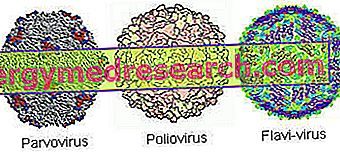Epidemic, Endemic and Pandemic - Definitions "The doctor of the plague", etching by Paulus Fürst 1656 (from J. Columbina). During the plague epidemic of 1656, in Rome, doctors believed that this clothing protected from infection. They wore a waxed cloak, a sort of protective goggles and gloves.
Category infectious diseases
What is TBE? TBE is the acronym of Tick-Borne Encephalitis, a meningoencephalitis transmitted by ticks infected by a virus belonging to the genus Flavivirus : it is a viral pathology with an acute course, which mostly affects the central nervous system. The TBE is inserted three diseases transmitted by ticks, discovered only recently: in fact, it was extensively described for the first time in 1994 in the province of Belluno, despite the same symptoms were already observed towards the end of the thirties of the twentieth century, in Russia
Nematode parasite Trichinella is a nematode parasite, the protagonist of infections known as trichinosis or trichinellosis : we are talking about a ubiquitous cylindrical worm in nature, transmitted to humans by ingesting infected, raw or undercooked meat. Trichinella infections require immediate drug therapy: the treatment delay can be fatal for the victim
What are plantar warts? Plantar warts are small but very annoying skin growths that originate between the toes or along their plant. Still caused by an infection sustained by the Papilloma virus, plantar warts are fortunately a phenomenon that, however irritating and unpleasant, turns out to be self-limiting and easily treatable
Definition The plantar warts are small skin protuberances, often painful and annoying, which can develop in any area of the sole of the foot or involve only the fingers. Similar to the other types of warts, even the plantar ones are caused by the papilloma virus: penetrating the skin through microlesions, the pathogen manifests all its virulence producing tiny skin growths that take on the typical yellow-greyish color and a characteristic rounded shape. Di
Generality The fecal-oral route represents a particular mode of transmission of various infectious pathologies. As you can easily guess from its very name, the transmission of a pathogen by the fecal-oral route occurs when the latter passes from the faeces of a sick subject to the digestive system of a healthy individual, generally through contaminated food, but not only
Definition of viremia Similar to bacteremia, viremia describes a condition in which pathogenic infectious particles (viruses, in this case) spread in the blood: the word viremia , extracted from medical language, is synonymous with a serious viral infection, to the point that the infecting agent, penetrating into the bloodstream, has free access to the remaining anatomical sites of the body, including cells, tissues and organs
Generality Respiratory syncytial virus (RSV) is the leading cause of bronchiolitis and pneumonia in children under the age of two . It is a ubiquitous and very contagious viral agent; transmission can be by air or by direct contact with the infected material and nasal secretions containing the pathogen
Phagocytosis [from phagein , eat + cyto , cell + - sis , process] allows the cell to absorb viruses, bacteria, whole cells and their debris, and any other kind of particulate. Many protozoa and some monocellular eukaryotes, such as amoebas, make phagocytosis their fundamental strategy to get the nutrients they need
What is Bronchitis? Bronchitis is the acute or chronic inflammation of the mucosa of the bronchial tree (complex of ducts that allows the exchange of air between the lungs and the external environment). In acute bronchitis the infectious processes are of great importance, while in the chronic one there are often environmental or voluptuous factors, such as smoking and pollution
Generality Pneumonia is an inflammatory process that affects one or both lungs. Causes Generally, pneumonia is caused by bacterial, viral or more rarely fungal infections. Also the inhalation of liquids or chemical substances, as well as the suction in the tracheobronchial tree of food residues and digestive juices, determines the inflammatory typical of the disease (in these cases we speak of pneumonia ab-ingestis)











